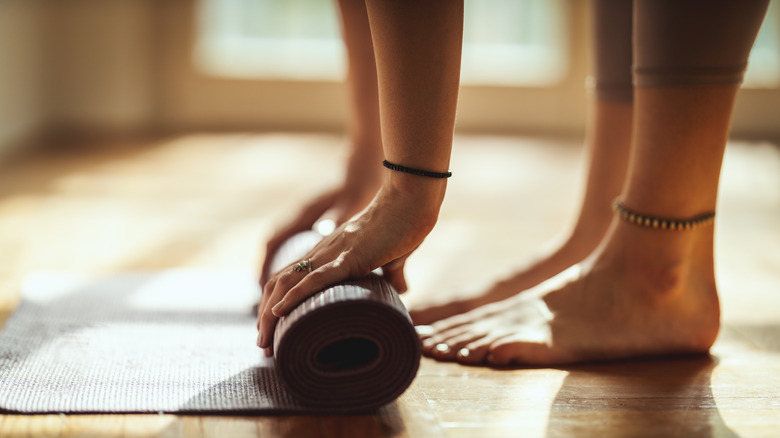How To Incorporate A Sound Bath Into Your Self-Care Routine
Most days, our idea of de-stressing doesn't involve much more than vegging out on the couch, maybe doing a gentle facial massage, or catching up with our favorite show. There's nothing wrong with this, but it might help to switch up one's daily self-care routine to include something more meditative and conducive to deeper relaxation, not just for the body but also for the mind.
Sound baths may sound like yet another trendy wellness practice social media has glommed onto, but meditating with the help of sounds has been practiced by indigenous communities for centuries. From the use of Tibetan singing bowls to the Australian Aborigines' didgeridoo, different native cultures have harnessed the power of musical tools to create low-frequency sounds that invite the body to soften and the mind to release stressful thoughts.
A sound bath is when you sit or lie down and listen to the sounds created by certain instruments. It can be experienced alone or with a group, live or through a recording. While it's possible to study how to play, for example, singing bowls for your personal practice, it's better to attend a class with a trained instructor first to get a better sense of how good a sound bath should make you feel.
What happens to the brain during a sound bath?
A 2017 study with 62 participants discovered that sound meditation helped reduce their depression and anxiety, and increased their sense of spiritual well-being. Also promising is its finding that those who had no prior meditation experience showed greater levels of change in their moods. Specifically, the age group of 40- to 59-year-olds reported a significant decrease not just in their body tension, but also in their physical pain.
Research remains inconclusive, however, about the reasons behind these effects. The brainwave entrainment hypothesis is offered as a possible explanation. It assumes that the brain's electrocortical activity can be induced to move at the same frequency as external stimuli. One such stimulus is binaural beats where two tones of different frequencies create a "third tone" that's also of a different frequency. This is the kind of sound produced by singing bowls, gongs, bells, and tuning forks.
According to Psychology Today, there have been studies that show preliminary evidence where binaural beats that are turned to a certain frequency help the brain come down from a vigilant state to a calmer one. Listening to them is also believed to increase the body's melatonin level while decreasing cortisol in the nervous system, thus facilitating better sleep. Despite the lack of definitive data on these benefits, the low risk offered by the practice makes it an attractive method for relaxation.
Start your sound bath practice with a tranquil setting
Aside from its promising effects, sound baths also have a low entry barrier for those who are total novices to meditation in general. You just need to be intentional in starting your practice.
Whether it's in the morning after waking up, during a lull in the middle of the day, or before turning in at night, immersing yourself in a sound bath becomes effective when you consciously make space for it. Schedule it at a time when you know you won't be distracted by pending responsibilities. Find a quiet corner in your home or room and make it comfortable for you to settle in. Lay out a yoga mat with cushions and a blanket, though you can also sit on the couch or recline on your bed. For an additional calming effect, dim the lights or draw your curtains closed and light a candle or an incense stick. Turn your phone off or put it in silent mode to avoid any distractions from messages and notifications.
It might be difficult to "unplug" if you don't consistently practice meditation, so try to do a sound bath on a regular schedule. That way, you gradually condition yourself to slow down at a certain time of the day. Licensed holistic therapist Megan Sherer also advised (per Bustle) easing into your practice with a 30- to 60-minute session once a week. You can increase the duration and frequency as you get the hang of it.
Use headphones or speakers to amplify your sound bath
If you have a tight budget, schedule, and can't afford to join a live sound bath session, make use of the many sound bath videos available on YouTube, Instagram, and TikTok. Just put on a pair of headphones or use a speaker for a better listening experience and also to block out other distracting sounds.
@carrieann_bailey Sleep Soundbath – 10mins #soundbath #sleep #sleepsounds #sleepsoundtrack #soothing #spirituality #healing #wellness #spiritual #reiki #10mins #meditation
To help you pick which videos to play, most sound bath creators helpfully classify their content based on their specific intentions, such as combating stress and anxiety, facilitating deep sleep, sparking creativity, and nurturing positive vibes. There are even ones that come with a guided meditation for total newbies. Aside from YouTube and social media, there are also meditation podcasts dedicated to playing binaural beats to listeners. They can be as brief as 10 minutes and as long as 8 hours, or even more. Some also combine nature sounds like beach waves, rain, and rustling leaves with the vibrations from singing bowls and gongs. Explore as many sources as you want to find the audio that suits you best.
Consciously let go of any tension in your body
Because of how we accumulate stress throughout the day, it's easy to ignore the tension we hold in our muscles all over our body. Even when we're seated or lying down, we might still unconsciously hold on to tightness. This is where guided sound baths come in handy. Aside from the calming effect of the binaural beats, the instructor can also advise you on how to do breathwork properly to release physical and mental tension.
Psychologist and meditation expert Tara Brach recommended doing a body scan as you take full, deep breaths, calming your body more and more with each exhale: "Start at the scalp and move your attention slowly downward, methodically relaxing and softening each part of the body." This approach helps you notice how even the small muscles of the face — the forehead, the eyelids, the jawline, the lips, and the tongue — hold tension. "Consciously releasing body tension will help you open to whatever arises during your meditation," she explained. With your focus drawn away from any mental clutter, you then become more receptive to listening to the sounds and experiencing their effects.
There are limits to what sound baths can do
It's important to be aware that sound baths may not be for everybody. Unplug Meditation CEO and founder Suze Yalof Schwartz explained to Good Housekeeping that a sound bath's combination of sounds and vibrations could trigger the nervous system negatively, especially for those who have neurological disorders, experience seizures or epilepsy, or suffer from migraines. Pregnant women could also develop adverse reactions. She advised consulting a doctor first before jumping into the practice.
Managing your expectations about what a sound bath can do for you is also crucial. Healthline cautioned against relying on it as a form of treatment for any mental health issue. It's still better to work with licensed professionals to properly address one's mental disorders and discuss with them the possibility of using sound baths as a complementary form of therapy. That way, you can avoid getting distressed from any untoward sensations, feelings, or thoughts that the sounds and vibrations might evoke within you.




